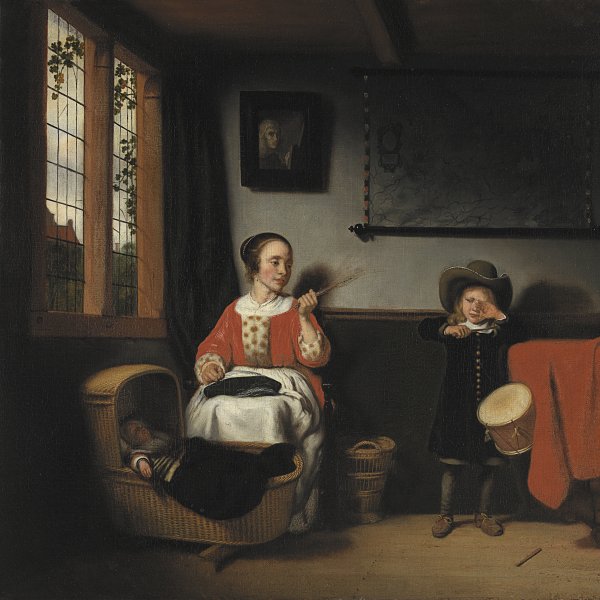Coastal Scene with Sailing Vessels
1655 - 1660
Oil on canvas.
67.3 x 58 cm
Museo Nacional Thyssen-Bornemisza, Madrid
Inv. no.
79
(1964.11
)
ROOM 28
Level 2
Permanent Collection
Jan van de Cappelle was a self-taught artist who combined his artistic activities with that of a prosperous cloth dying business inherited from his father. In addition, he was an important collector of Dutch painting, as is evident from the inventory of his collection drawn up one year after his death in 1680 and which records around 200 paintings and a large number of drawings. Among the paintings and drawings listed are works by landscape artists such as Hendrick Avercamp, Esaias van de Velde the Elder, Rembrandt (represented by a large number of sketches), and the marine painter Simon de Vlieger who was particularly well represented in Cappelle’s collection. Among the paintings were three by Rubens, seven by Rembrandt and others by Hercules Segers, Frans Hals and Jan Porcellis. Cappelle thus had the opportunity to make a first-hand study of the works of these artists, assimilate their lessons and apply his conclusions to his own production.
Cappelle executed tranquil, harmonious marine views and invented a type of work known as a “parade” scene in which ships are moored in ports or estuaries while salutes are fired, or groups of dignitaries in small boats approach or depart from these vessels during the celebration of a particular event. Van de Cappelle’s compositions are considered to be classic examples of Dutch marine painting due to their perfection and the mastery of the elements within them.
Coastal View with Sailing Vessels, dated to the second half of the 1650s, is signed by the artist using a double “p” and double “l”, a spelling that he started to use in the 1650s, according to Russell. The artist organised the ships into two lines, creating an empty space in the centre that allows for a view to the brightly lit horizon that creates another visual focus point. The artist’s interest focuses on capturing the atmosphere rather than on a depiction of the vessels, and this is conveyed through the light and its reflection, with the sails brightly lit or back-lit and their shadows and reflections falling on the calm water. Some of these effects are evident in the foreground in which the sea is illuminated in certain areas by these reflections, which in places even include the colours of the clothes of the figures on board. This carefully organised composition opens out on each side with small boats full of passengers that lead the eye into the middle-ground where Cappelle has located larger vessels.
In the mid-19th century the canvas was in the collection of Henry Danby Seymour where it was seen by Waagen who catalogued the painting as a work by Willem van de Velde the Younger. As Gaskell noted, this erroneous attribution may have been due to the condition of the painting at that date and the difficulty of reading the signature. In addition, during the 18th and 19th centuries the work of Van de Velde was more highly esteemed than that of Cappelle.
Mar Borobia
Cappelle executed tranquil, harmonious marine views and invented a type of work known as a “parade” scene in which ships are moored in ports or estuaries while salutes are fired, or groups of dignitaries in small boats approach or depart from these vessels during the celebration of a particular event. Van de Cappelle’s compositions are considered to be classic examples of Dutch marine painting due to their perfection and the mastery of the elements within them.
Coastal View with Sailing Vessels, dated to the second half of the 1650s, is signed by the artist using a double “p” and double “l”, a spelling that he started to use in the 1650s, according to Russell. The artist organised the ships into two lines, creating an empty space in the centre that allows for a view to the brightly lit horizon that creates another visual focus point. The artist’s interest focuses on capturing the atmosphere rather than on a depiction of the vessels, and this is conveyed through the light and its reflection, with the sails brightly lit or back-lit and their shadows and reflections falling on the calm water. Some of these effects are evident in the foreground in which the sea is illuminated in certain areas by these reflections, which in places even include the colours of the clothes of the figures on board. This carefully organised composition opens out on each side with small boats full of passengers that lead the eye into the middle-ground where Cappelle has located larger vessels.
In the mid-19th century the canvas was in the collection of Henry Danby Seymour where it was seen by Waagen who catalogued the painting as a work by Willem van de Velde the Younger. As Gaskell noted, this erroneous attribution may have been due to the condition of the painting at that date and the difficulty of reading the signature. In addition, during the 18th and 19th centuries the work of Van de Velde was more highly esteemed than that of Cappelle.
Mar Borobia









